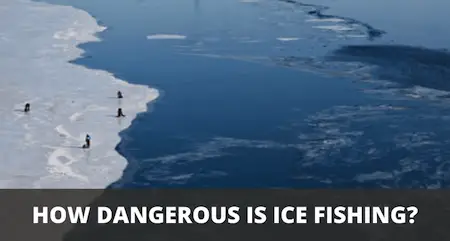How Dangerous Is Ice Fishing, And What Can You Do To Ensure Ice Fishing Safety?
UPDATED 18 MAY 2023
by Robert Ceran
A common question I get from fishing newbies, as well as from their concerned relatives is “how dangerous is ice fishing?”
Here’s the quick answer:
Ice fishing is generally a safe sport if you take all necessary precautions, don’t take foolish risks, and are ready to respond correctly if an accident does occur.
Most accidents and deaths happen when people are either not appropriately prepared, or take unnecessary risks, or both.
Having said that, I’d like to point out that ice fishing comes with bigger risks than traditional fishing, and so can be very dangerous if you don’t know what you’re doing, or don’t take safety precautions seriously.

The best way to avoid this is by making sure you educate yourself on all safety issues, and are optimally prepared when you go out on the ice.
What are the biggest dangers of ice fishing?
Many people mistakenly believe that the biggest risk while ice fishing is the possibility of falling through the ice and drowning.
But a study published in 2016 by researchers at the Mayo clinic has shown that this only accounts for a small percentage of the ice fishing related injuries.
The researchers studied 85 ice fishing related injuries, and found that the vast majority of them (89%) consisted of bruises, cuts, broken bones, and other trauma caused by falling on the ice.
Below is an overview of the different categories of ice fishing related injuries reported by the Mayo clinic study, and how often they occurred:
| Type of injury | Percentage of cases |
|---|---|
| Bruises, sprains & broken bones | 46% |
| Minor trauma (small cuts, etc.) | 37% |
| Major trauma (concussion, etc.) | 6% |
| Burns | 5% |
| Water immersion, drowning | 5% |
| Frostbite | 1% |
Table 1: The most common ice fishing related injuries reported by a Mayo clinic study in 2016 (source)
Most common injury of ice anglers: trauma caused by falling on the ice
Based on the results of the researchers, the most common risk you need to be aware of is the danger of slipping and falling on the ice.
This can happen either if the ice has a very smooth surface (which is common with relatively new ice that doesn’t have snow cover), or if you step into an open ice fishing hole.
Unfortunately, it’s quite common for anglers to leave ice holes without marking them for other anglers.
While it’s very unlikely that you can fall through an ice hole that’s 10 inches wide or smaller, it can cause you to trip and fall onto the ice, which is the most common cause of ice fishing injuries.
Falling through the ice
While injuries caused by falling through the ice were only 5% of the cases reported by Mayo Clinic, these are obviously among the most dangerous ones, so need to be taken very seriously. We’ll discuss how to avoid this, and how to deal with this situation if it does occur below in the article.
Burns
Interestingly, injuries from burns were just as common as falling through ice. These are due to fire caused by heaters in ice fishing huts. These heaters can even cause carbon monoxide poisoning since they are used in the confined space of a small ice shanty, where a leak can quickly have negative effects.
Frostbite
While frostbite was the least common injury observed by the researchers, you obviously need to be well prepared to withstand sub zero temperatures for an extended period of time. So dress appropriately with multiple layers of thermal insulation.
Dangers related to ice thickness
Humans are generally safe to walk on ice that’s at least 4 inches thick. Here are the ice thickness recommendations of the Minnesota Department of Natural Resources for different types of activity on ice:
4 inches – walking on foot
5-7 inches – snowmobile or ATV
8-12 inches – car or small pickup
12-15 inches – medium truck
These recommendations are for clear ice. If you’re on white ice, double these values to stay on the safe side.
It’s important to note that ice is never 100% safe, since it can vary a lot in thickness on the same lake, plus it can vary in quality, which can result in a reduced ability to carry weight (see below for more information).
As a rule of thumb, ice is thinner near the shore, and thicker in the middle of the lake. In addition, ice can be thinner in places where there is a current of water moving under the surface, or if there are sunken trees or other objects under the surface.
Don’t rely on the authorities or other anglers to tell you how thick the ice is. Instead, test the thickness yourself at regular intervals when you go out. You can use your ice auger plus a tape measure to do this, or with a spud bar early in the season.
The most dangerous times are early in the winter season, when the ice is still not very thick, or during the transition from winter to spring, when it starts to thaw.
Dangers related to ice quality
As already mentioned, all ice isn’t always the same. It can vary in thickness on the same lake. In addition, the quality of the ice can also vary greatly, especially as the winter season progresses, and it’s essential to know how to recognize low quality ice.
Here are the main quality categories of ice:
Clear ice: best quality (usually fresh ice in early winter)
White ice: lower quality (formed after snow falls on the ice)
Grey ice: lowest quality (usually a sign of thawing ice, which is very dangerous)
If you’re on clear ice, you can use the thickness recommendations of the Minnesota Department of Natural Resources given above. If you’re on white ice, double those figures to stay on the safe side. If you see grey ice, stay off the ice completely. This often occurs in spring, when the ice starts melting, which is very dangerous.
A great way to test ice quality while you’re walking on it is to strike the ice twice in the same location with your spud bar. If the surface of the ice doesn’t break, then the quality should be good enough to carry your weight.
Additional ice fishing safety precautions you need to know
Now let’s talk about what you can do to avoid dangers on the ice. These fall into two main categories: knowing how to avoid accidents, and knowing what to do if accidents do happen.
The most important safety precaution is this: never go ice fishing alone. Many situations are much more dangerous if there’s no one around to help you. So make sure you’re always out together with at least one other angler, and that both of you are well versed in ice safety.
How to avoid ice fishing hazards
- Follow ice thickness safety precautions
- Follow ice quality safety precautions
- Never go ice fishing alone
- Regularly check your heater for fire hazards
- Wear a non-slip traction device on your boots to avoid falling
- Mark fishing holes to avoid stepping into them
- Wear appropriate clothing to keep warm, and use a portable ice fishing heater.
What to do if you fall through the ice
If you do fall through the ice, you should be prepared to deal with it. The best way to prepare for this possibility is to wear a flotation device, and to have a pair of ice picks (also called ice claws) around your neck at all times.
The floatation device will help you stay afloat, and the ice picks will help you get back onto the ice.
While many anglers don’t like flotation devices because they tend to cramp their movements, wearing one at all times is absolutely essential, and should never be up for debate.
You should also have a pair of ice picks fastened around your neck at all times. It may be possible to push yourself on to the ice without picks if the ice is strong, but this doesn’t work if the ice is weak, since it will just continue to break under your weight.
In that case the ice picks make all the difference, since they allow you to pull yourself across the ice while kicking your legs up onto it, thereby distributing your weight across a bigger surface of ice.
Once you’re back on the ice, roll yourself away from the hole until you reach stronger ice that you can get up on.
Final remarks
This concludes our article on the dangers of ice fishing. Please make sure you take all necessary precautions, and stay safe on the ice!
Hungry to learn more? Check out our beginners guide to ice fishing.
